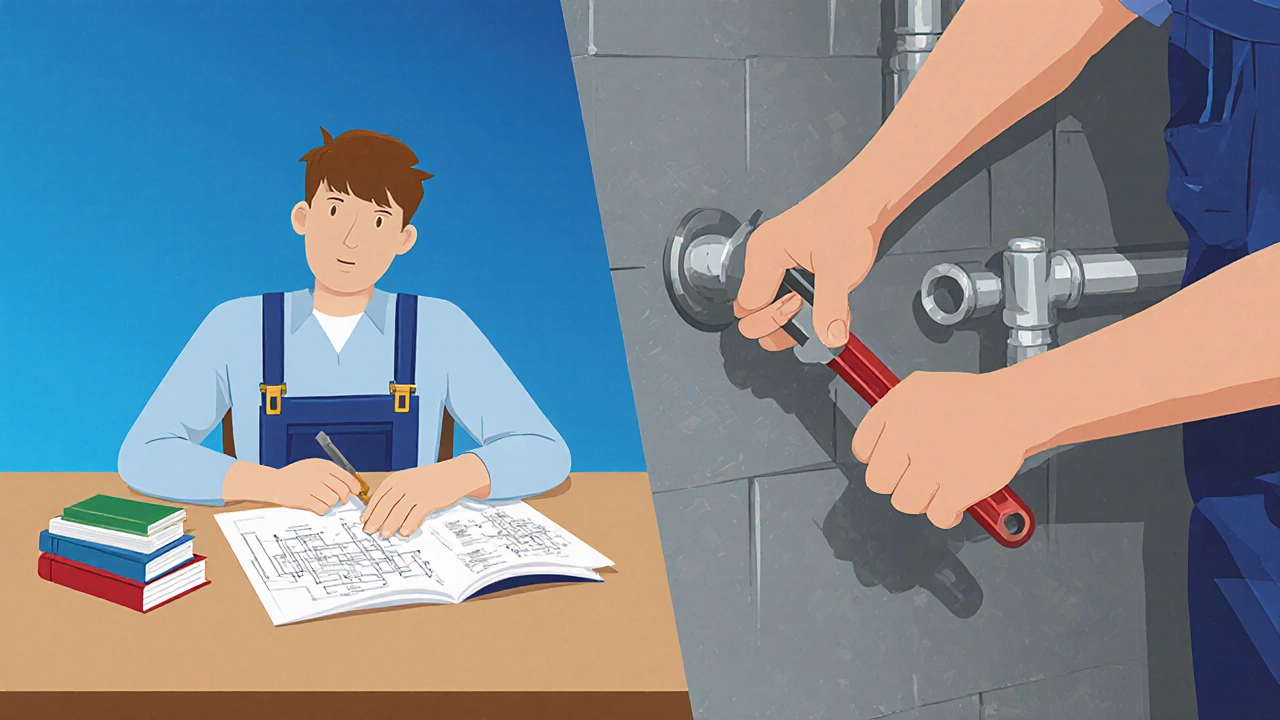Plumbing Cost Calculator
Calculate Your Plumbing Career Entry Costs
Want to become a plumber in the USA but worried about the cost? You’re not alone. Many people assume it’s a pricey career path-maybe even more than college. But here’s the truth: plumbing doesn’t require a four-year degree, and the total cost to get started is often under $10,000. That’s less than a year of community college tuition. And better yet, you can start earning while you learn.
What’s the real cost breakdown?
The total cost to become a licensed plumber in the USA breaks down into four main parts: training, tools, licensing, and exams. Most people take one of two paths: an apprenticeship or a trade school. Each has different costs and trade-offs.
If you go the apprenticeship route-which 80% of new plumbers do-you’ll typically pay little to nothing for training. Instead, you’ll work under a licensed plumber and get paid while you learn. The average apprenticeship lasts four to five years. During that time, you’ll earn between $15 and $25 an hour, depending on your state and experience level. By year four, many apprentices make over $20 an hour. That means you’re not just saving money-you’re building savings.
Trade schools are faster but cost more. A plumbing program at a community college or private trade school can run from $3,000 to $15,000. Most programs last six months to two years. For example, a 12-month certificate program at a public community college in Ohio might cost $4,200 in tuition. That includes textbooks and basic safety gear. Private schools like Lincoln Technical Institute charge closer to $12,000 for their 10-month plumbing technician program.
Tools: The hidden expense
One thing most people don’t think about until it’s too late: tools. You can’t work as a plumber without them. And no, your employer won’t give you a full set. You’ll need to buy your own.
A basic starter tool kit includes pipe cutters, wrenches, a pipe threader, a plunger, a drain snake, measuring tape, safety glasses, and work gloves. That’s about $800 to $1,200 upfront. If you want a full professional kit with power tools, pressure testers, and a toolbox, you’re looking at $2,500 to $4,000. Some apprenticeships help you buy tools through payroll deductions, so you pay a little at a time. Others give you a tool allowance after your first year.
Pro tip: Buy used tools from eBay, Facebook Marketplace, or local tool rental shops. Many experienced plumbers sell their old gear in great condition for half price. You’ll save hundreds without sacrificing quality.
Licensing and exams: Pay to play
Every state requires plumbers to be licensed. But the rules vary wildly. In California, you need 4 years of experience and must pass a 100-question exam. In Texas, you can get a journeyman license after 2 years of apprenticeship. In New York, you need both state and city licenses.
Exam fees range from $50 to $300, depending on the state. Licensing fees are usually $100 to $250 per year. Some states also require background checks ($30-$75) and liability insurance ($200-$500/year). Don’t forget renewal fees-most licenses expire every 2 to 4 years and cost the same to renew.
Some states offer free exam prep through workforce development programs. Check with your local Department of Labor or community college-they often have grants or vouchers to cover test fees for low-income applicants.

Financial aid and scholarships
You don’t have to pay out of pocket. There’s a lot of help available.
- Apprenticeship programs are often funded by unions like the United Association (UA) or local plumbing contractors’ associations. These programs pay you to learn and cover most of your costs.
- Trade school scholarships exist through organizations like the Plumbing-Heating-Cooling Contractors Association (PHCC) and the National Association of Home Builders (NAHB). Some offer $1,000 to $5,000 per student.
- GI Bill benefits can be used for plumbing school if you’re a veteran. The VA covers tuition, books, and even a housing stipend.
- State workforce grants are available in nearly every state. For example, Illinois offers up to $5,000 in tuition reimbursement for people in high-demand trades like plumbing.
Don’t assume you’re ineligible. Even if you’re not low-income, you might qualify for a scholarship based on your location, gender, or veteran status. Many programs are underfilled because people don’t apply.
How long until you break even?
Let’s say you spend $8,000 on trade school and $1,500 on tools. Total investment: $9,500.
After graduation, you’ll start as a junior plumber. The average entry-level wage is $18-$22 per hour. At 40 hours a week, that’s $37,440 to $45,760 a year. After taxes and expenses, you’re taking home about $30,000-$36,000.
That means you’ll pay off your investment in less than a year. After that, every dollar you earn is pure profit. By year three, most plumbers make $50,000-$70,000. With overtime, emergency calls, and side jobs, many hit $80,000+.
Compare that to a college grad with $30,000 in student debt making $40,000 a year. Who’s ahead? The plumber.
What’s the cheapest way to start?
Here’s the fastest, lowest-cost path:
- Apply for a union apprenticeship through your local UA chapter. No tuition. Paid work. Guaranteed job after completion.
- If no apprenticeship is available, enroll in a community college plumbing program. Costs under $5,000.
- Buy used tools from local classifieds or Facebook groups.
- Apply for state workforce grants and PHCC scholarships.
- Pass your state exam and get licensed.
This route can cost as little as $2,000-$4,000 total-and you’ll be earning from day one.

Common mistakes to avoid
Many people make these costly errors:
- Signing up for a private trade school without checking if it’s state-approved. Some schools charge $15,000 but don’t qualify you for licensure.
- Buying expensive new tools before you know what you need. Start basic. Upgrade later.
- Skipping the apprenticeship because you want to “get it done fast.” You’ll miss real-world experience-and your license might not be accepted.
- Not checking state requirements. One state’s journeyman license doesn’t transfer to another. Always verify with your state’s plumbing board.
Is plumbing worth it?
Yes-if you’re okay with getting your hands dirty. Plumbing isn’t glamorous. You’ll work in basements, crawl spaces, and freezing attics. You’ll deal with clogged toilets at 2 a.m. But you’ll never be out of work. Every house, apartment, and business needs a plumber. Demand is rising because of aging infrastructure, new construction, and a shortage of skilled workers.
The U.S. Bureau of Labor Statistics predicts a 10% growth in plumbing jobs by 2032-faster than average. That means more jobs, better pay, and more leverage when you negotiate your rate.
And here’s the best part: you don’t need to be a math genius or have a degree to succeed. You need patience, problem-solving skills, and a willingness to show up. The rest? You’ll learn on the job.
How long does it take to become a licensed plumber in the USA?
It usually takes 4 to 5 years through an apprenticeship. Some states allow you to take the journeyman exam after 2 years of experience, but full licensing often requires 4 years. Trade school can shorten the learning time to 6 months to 2 years, but you’ll still need to complete an apprenticeship or work under a licensed plumber to qualify for your license.
Can I become a plumber without a high school diploma?
Most apprenticeships and trade schools require a high school diploma or GED. However, some states allow you to start as a helper or apprentice without one, as long as you can pass basic math and reading tests. If you don’t have a diploma, consider getting your GED first-it opens more doors and makes you eligible for financial aid.
Do I need to be physically strong to be a plumber?
You don’t need to be a bodybuilder, but you do need decent strength and stamina. Plumbers lift heavy pipes, work in tight spaces, and stand for long hours. Most tasks involve using tools, not brute force. Many plumbers improve their strength gradually. If you’re in average shape and willing to stay active, you’ll be fine.
Are there any free plumbing training programs?
Yes. Many union apprenticeships are completely free-you get paid while you train. Some states also offer free or low-cost training through workforce development agencies. For example, the Department of Labor’s Apprenticeship.gov lists hundreds of paid plumbing programs with no tuition. Community colleges sometimes offer free courses for unemployed workers or veterans.
What’s the difference between a plumber and a pipefitter?
Plumbers work on water, waste, and gas systems in homes and buildings. Pipefitters install and maintain high-pressure pipes for industrial systems like steam, chemicals, or HVAC in factories and power plants. The training is similar, but the work environments and licensing are different. Most people start as plumbers because the demand is higher in residential areas.
Next steps: How to get started today
Ready to take the first step? Here’s what to do in the next 7 days:
- Go to apprenticeship.gov and search for plumbing programs in your state.
- Call your local UA (United Association) chapter. Ask how to apply for an apprenticeship.
- Check your state’s plumbing board website for licensing requirements.
- Visit your community college’s trades department. Ask about tuition costs and financial aid.
- Visit a local hardware store. Look at plumbing tools and write down what you’d need to start.
You don’t need to have it all figured out. Just take one step. The next one will show up.





Write a comment